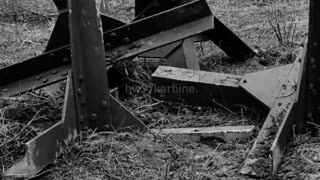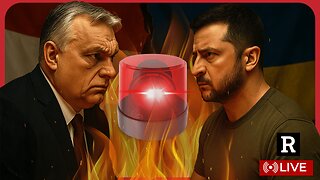Premium Only Content

Fallschirmjäger turn a captured Bofors 40mm gun against its former users on Crete in May 1941
The Battle of Crete, codenamed "Unternehmen Merkur" or Operatrion Mercury by the invading forces, was a major Axis airborne and amphibious operation during World War II to capture the island of Crete. It began on the morning of May 20th 1941 with multiple German airborne landings, while Greek and other Allied forces along with Cretan civilians defended the island.
After only one day of fighting, the Germans had suffered heavy casualties and the Allied troops were confident that they would defeat the invasion. The next day, through communication failures, Allied tactical hesitation, and German offensive operations, Maleme Airfield in western Crete fell, enabling the Germans to land reinforcements and overwhelm the defensive positions on the north of the island. Allied forces withdrew to the south coast. More than half were evacuated by the British Royal Navy and the remainder surrendered or joined the Cretan resistance. The defense of Crete evolved into a costly naval engagement for the British, and by the end of the campaign the Royal Navy's eastern Mediterranean strength had been reduced to only two battleships and three cruisers.
The Battle was notable for several reasons. It was the first occasion where Fallschirmjäger were used en masse in what was the first mainly airborne invasion in military history. Intelligence from decrypted German messages from the Enigma machine was also employed for the first time by Allied forces. German troops also encountered mass resistance from a civilian population to a degree they had hitherto not experienced during the conflict.
Due to the number of casualties and the belief that airborne forces no longer had the advantage of surprise, Adolf Hitler became reluctant to authorize further large airborne operations, preferring instead to employ paratroopers as ground troops. This was one of the factors that resulted in Unternehmen Herkules, the planned invasion of Malta, to be postponed indefinitely, a decision that would have a significant influence on the Mediterranean campaign. In contrast, the Allies were impressed by the potential of paratroopers and would use such forces of their own with varying degrees of success later in the war.
0:00 A captured QF 40mm Mark III gun, a version of the Swedish Bofors 40mm Automatic Gun L/60 built under license by in Britain, is fired German Fallschirmjäger against their former users. While nominally an anti-aircraft weapon, its impact fuzed 900 high explosive shells weighing almost a kilogram each would also prove useful against targets on the ground, fired at a muzzle velocity of 900 meters per second. The type was put into official German use as the 4cm Flak 28 with a good number of examples captured from Poland, France and Norway as well as newly manufactured guns made in Hungary.
0:20 Several British vehicles inclusing a Morris CS8 light truck and Universal Carrier are put into Fallschirmjäger use, as the paratroopers tended to travel light such captured equipment was especially useful.
0:34 3.7cm Pak 36 anti-tank guns towed into action by motorcycle, likely belonging to Kradschützen-Bataillon 55. This footage was likely captured in the final days of the battle, with the more nimble motorcycle troops being better able to keep pace with the retreating enemy forces.
0:49 Men likely from Gerbirgs-Artillerie-Regiment 95 fire a 7.5cm Gebirgsgeschütz 36. Like the motorcycle troops these units were better able to keep pace with the retreating enemy, however being relatively lightly equipped they were unable to prevent the evacuation of more than half of the British garrison.
-
 8:12
8:12
hw97karbine
1 month agoUS WWII trials evaluating the effectiveness of obstacles for armored vehicles
3873 -
 LIVE
LIVE
BonginoReport
2 hours agoBig Bad JB Threatens Trump! - Nightly Scroll w/ Hayley Caronia (Ep.120) - 08/26/2025
14,669 watching -
 LIVE
LIVE
Dr Disrespect
7 hours ago🔴LIVE - DR DISRESPECT - GEARS RELOADED GLOBAL LAUNCH - CRUSHING LOCUST
1,715 watching -
 LIVE
LIVE
SpartakusLIVE
4 hours ago$20,000 Hide and Seek Tourney w/ Stonemountain64 || #1 Rat wins the BIG CHEESE
394 watching -
 1:02:26
1:02:26
Kim Iversen
2 hours agoIran Rejects Nuclear ‘Spy’ Inspectors — War Next?
20.2K29 -
 LIVE
LIVE
StoneMountain64
6 hours agoWARZONE LEGEND RETURNS. GHILLIE SUIT $20k TOURNEY.
164 watching -
 1:06:33
1:06:33
TheCrucible
2 hours agoThe Extravaganza! EP: 27 with Guest Host: Rob Noerr (8/26/25)
11.4K2 -
 LIVE
LIVE
GloryJean
8 hours agoHide & Seek Tournament w/ Spartakus, StoneMountain64 & Stevie
55 watching -
 LIVE
LIVE
Reidboyy
5 hours agoNEW FREE FPS OUT ON CONSOLE NOW! (Delta Force = BF6 with Killstreaks)
28 watching -
 1:37:26
1:37:26
Redacted News
3 hours agoHIGH ALERT! DID UKRAINE JUST DECLARE WAR ON HUNGARY? ZELENSKY DEMANDS MORE CASH FROM NATO | REDACTED
142K74